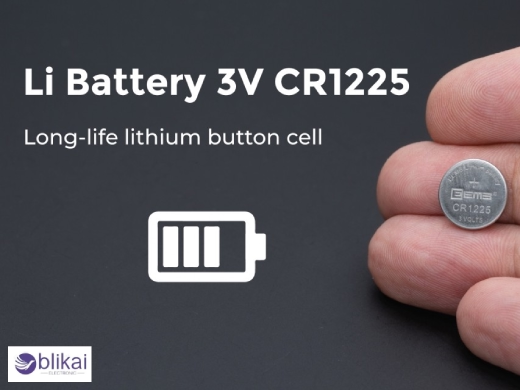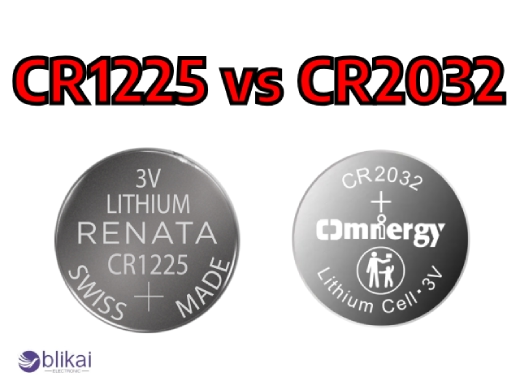CR1225 vs CR2032: Differences, Battery Life & Application
Physical Characteristics of CR1225 and CR2032
Size and dimensions comparison
Three major differences exist in the dimensions of CR1225 and CR2032 batteries, which power microelectronic devices. The dimensions of 12.5mm diameter to 2.5mm height make this battery type smaller than the CR2032. CR2032 provides a 20mm diameter alongside a 3.2mm height, which leads to bigger dimensions than the CR1225.
Weight differences
The significant differences in physical measurements of these batteries cause them to display varied weight measurements. The weight of CR1225 batteries reaches 0.9 grams, while CR2032 batteries maintain approximately 3 grams of weight. Weight precision matters in applications that use miniature equipment and weight-dependent devices; therefore, the weight distinction holds high importance.
Voltage output
The CR1225 battery joins the CR2032 because both work as lithium coin cell batteries that produce standard 3 volts. The batteries function through a steady voltage which allows them to work interchangeably within applications that need medium capacity and maximum power.
Capacity (mAh) comparison
The main disparity between these batteries appears through their mAh ratings. A CR1225 battery of reduced dimensions supplies between fifty and 50 mAh capacity. A CR2032 provides more storage capacity since its electricity rating reaches between 210 to 240 mAh. A battery's lifespan before needing replacement and its operational works are both directly influenced by the capacity difference between them.
|
Feature |
CR1225 |
CR2032 |
|
Size (Diameter × Thickness) |
12mm × 2.5mm |
20mm × 3.2mm |
|
Capacity (mAh) |
~48-55 mAh |
~210-240 mAh |
|
Voltage |
3V |
3V |
|
Weight |
~0.9g |
~3.1g |
|
Chemistry |
Lithium Manganese Dioxide (Li-MnO₂) |
Lithium Manganese Dioxide (Li-MnO₂) |
Battery Life Expectancy
Factors affecting battery life
Several main elements determine the usable time for coin cell batteries, including CR1225 and CR2032. The battery life gets substantially reduced when devices consume high current. Climate temperature affects the performance of electrical devices because severe environmental heat or cold temperatures create operational complications. The manufacturing quality of the battery, together with its materials selection along production methods, determine how long it will last. Storage conditions, together with shelf life, require attention from consumers.
Typical lifespan of CR1225
The reduced size of CR1225 batteries results in lower operational time than CR2032. Standard use of CR1225 devices provides battery life ranging from one to three years. The actual lifespan of CR1225 batteries depends heavily on their user application scenario. Small remotes or calculators using CR1225 batteries tend to survive longer durations before needing replacement, but their operational period shortens in high-drain devices.
Typical lifespan of CR2032
The extended size and storage capacity of CR2032 batteries provide them with longer durability than CR1225 batteries. A CR2032 battery exists on the market for 3 to 5 years based on regular usage patterns. Both low-drain devices, including watches and car key fobs, extend the battery life of CR1225 and CR2032 batteries to 10 years. The period of use for high-drain devices, as well as strongly used devices, falls within the range of 1-2 years.
Self-discharge rates
CR1225, alongside CR2032, exhibits minimal self-discharge that enables these batteries to stay usable for extended periods. Batteries remain in a usable condition during room temperature storage because their capacity decreases by about 1% each year. The devices can maintain their stored charge throughout multiple years of storage. The self-discharge rates of CR2032 batteries are slightly lower because of their bigger dimensions and larger capacity combination.
Common Applications
Devices using CR1225
The CR1225 battery functions in different types of small electronic equipment systems. The CR1225 battery operates most widely in key fobs and small remote controls as well as fitness trackers. Its compact dimensions make this battery optimal for glucose meters as well as small hearing aids for medical use. CR1225 batteries maintain power supply systems in several compact calculators together with digital watches.

Devices using CR2032
The CR2032 battery offers increased power capacity due to its size and thus serves different types of electronic equipment. These batteries appear commonly in computer motherboards as well as car keypads, garage door remotes, and numerous small remote devices. Various electronic devices, including digital scales and heart rate monitors, as well as glucometers, utilize CR2032 batteries as power sources. The CR1225 power supply is present in LED lights along with toys and small electronic devices which include pedometers and bicycle computers.
Interchangeability in certain applications
Both CR1225 and CR2032 batteries possess unique dimensions but share certain interchangeable conditions when used in appropriate equipment compartments. The battery compartment flexibility of various devices permits interchangeable use between the two battery types. When a CR1225 battery replaces a CR2032 battery it shortens the battery runtime because CR1225 has less overall capacity. The CR2032 battery might exceed the dimensions of areas meant for CR1225 batteries. Refer to the instruction manual of your device before attempting battery exchange to maintain functional operation while preventing any equipment damage.
|
Application |
CR1225 |
CR2032 |
|
Wristwatches |
✅ Common |
❌ Too large |
|
Small IoT sensors |
✅ Used |
❌ Less common due to size |
|
Key fobs |
✅ Some models |
✅ More common |
|
Medical devices (glucometers, hearing aids) |
✅ Some |
✅ Common |
|
Motherboards (CMOS backup) |
❌ Too small |
✅ Common choice |
|
Remote controls |
❌ Limited use |
✅ Common |
|
LED blinkers (small circuits) |
✅ Used |
✅ Longer life |
Performance in Different Conditions
Temperature tolerance
A temperature variability does not deliver identical performance outputs from CR1225 and CR2032 batteries. The operational range of batteries extends between -20°C to 60°C (-4°F to 140°F). The CR2032 battery performs best at extreme temperatures due to its enhanced capacity, which coincides with its bigger dimensions.
The voltage output of CR2032 batteries stays more stable in cold temperatures, which makes them appropriate for winter usage of outdoor devices and equipment. The performance output of CR1225 batteries decreases noticeably when placed in cold conditions.
Humidity resistance
Sealed casings on CR1225 and CR2032 batteries exist to block the ingress of moisture from their environment. The constructed battery casing successfully prevents water damage in typical ordinary environments. Excessive exposure to high humidity might cause negative results on battery lifespan while reducing performance capabilities.
The larger dimensions of CR2032 batteries grant them increased superiority in moist environments because they have room for better moisture defenses inside their structure. The best conditions to achieve peak performance of both battery types consist of controlled environments when feasible.
Shock and vibration resistance
The solid-state composition of CR1225 and CR2032 batteries permits these devices to endure physical pressure effectively. Due to its thicker protective shell and bigger size, the CR2032 battery maintains limited advantages in fighting shock and vibration damage.
Because of their sturdy construction, CR2032 batteries serve best in movable gadgets like wearable technology alongside automobile applications. High-stress conditions present a greater risk of damage to CR1225 batteries because they combine small size with a thin construction.
Environmental Impact and Disposal
Materials used in manufacturing
Just like the CR2032 and CR1225 batteries, lithium coin batteries have constituent parts such as lithium, manganese dioxide, and trace amounts of other metals, which may have some environmental ramifications as well. Active mining regions are prone to practically every issue, including loss of biodiversity due to mining itself and working factories due to the necessary production processes associated with mining these components.
Recycling options
Disposing of coin batteries properly greatly reduces their environmental harm. Electronics and battery stores often have a bin to collect old batteries. These specialized recycling centers are equipped to collect important materials such as lithium, amongst other metals, which reduces the need to harvest more raw materials. Certain companies also subsidize their customers and motivate them to bring back spent batteries for the right recycling process.
Proper disposal methods
Letting the overly dominant corporations mine with no consequence or properly monitoring overproduced trash is never the way to go. To help offset the pollution done by CR2032 and CR1225 batteries, proper disposal methods, along with claiming kiosks for other electronic waste, lessen the dire consequences to our earth further with us taking advantage of offered collection events.
Choosing the Right Battery for Your Needs
Assessing device requirements
Your device requirements must be known before switching between CR1225 and CR2032 batteries. Users can obtain the preferred battery information by checking their device manual or visiting the manufacturer’s website. The main difference stems from the capacity measurements since these batteries both deliver 3-volt power. Always verify the voltage specification before making a replacement.
Considering space constraints
The ultimate decision regarding battery selection depends on both dimensions of a chosen device. The CR1225 offers better technical advantages over the CR2032 because it maintains a thinner and smaller form that suits applications in watches, small calculators, and key fobs. The CR1225 should be chosen when limited space is essential since it fits efficiently yet the CR2032 is a better choice when plenty of space exists because it allows longer operation duration.
Evaluating long-term cost-effectiveness
While the CR1225 batteries have an advantage in price, think of it in the long run. The difference in the lifetime capacity of the battery suggests that CR20302 replacements would be needed less often. For each prolonged period, determine the objective value in terms of both the batteries' costs and the hassle of swapping them out frequently.
Weighing performance factors
Take into account the device's usage habits and battery consumption. The greater capacity of the CR2032 might offer improved performance and longevity for devices that are often used or have high drains. However, a CR1225 might be adequate for low-power devices or ones that are used occasionally. Additionally, consider the working environment. Depending on how well each battery performs in these circumstances, harsh temperatures or high humidity may affect your decision.
Related Articles
CR2032 vs CR2025: Which One to Pick Up?
CR2450 vs CR2032 Battery: What are the Differences?
CR2032 vs LR44: Key Differences, Application & Battery Comparison
CR1225 Battery Equivalent: Applications and Features
CR1225 Battery: Applications, Features and Specifications
Cr2 vs Cr123: Which Battery Is Right for You? [Explained]
How To Charge Lead Acid Battery: [Explained]
The Ultimate Guide to CR1220 Battery
Comparison of CR2016 Battery and CR2025 Battery
LR44 Battery: Everything You Need to Know [2024 Updated]
CR1616 vs CR2025 Battery
Lithium cr1620 Battery:Features, Specification and Applications
H7 AGM Battery: Applications, Features and Equivalent











